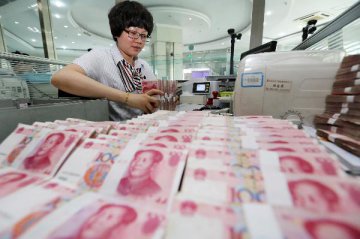
One of the less obvious beneficiaries of a resolution from the U.S.-China trade war is shaping up to be the $13 trillion Chinese bond market.
China has already been welcoming record inflows into its local-currency debt after making it easier for foreign investors to access domestic securities and winning inclusion in a key global bond index. Now another hurdle is set to fall, should bilateral trade negotiations in coming weeks cement the deal that officials say is taking shape.
An agreement could help solidify expectations for a stable yuan exchange rate, removing any incentive China might ever have had to use it as a retaliatory tool; such concerns hurt the currency last year. It would also clear away the concerns of some investors about diversifying into Chinese debt amid a charged geopolitical environment.
“Evidence from conversations with clients suggests that any trade deal can only be positive for Chinese bond inflows,” said Teresa Kong, a San Francisco-based portfolio manager at Matthews Asia.
Investor Angst
CIOs -- chief investment officers -- as a rule tend not to speak on the record about political concerns with regard to China, but those worries have been apparent nonetheless. Monthly inflows to Chinese bonds topped out late last year, China’s sovereign dollar-bond offering in October saw diminished American demand and the biggest Chinese bank surprised market participants by canceling a dollar-security sale in November.
The exchange rate itself has become part of the trade talks, amid U.S. concerns over China’s potential depreciation, and that’s raised expectations for a clause to be included in the final agreement. While Chinese officials have been wary of any currency commitment, expectations of yuan stability have grown as negotiations progressed.
Yuan Factor
“The immediate reaction to a favorable trade deal will likely mean renminbi appreciation, and that might mean investors will be willing to add the weighting to China earlier,” said Stephen Chang, executive vice president and portfolio manager for Asia at Pacific Investment Management Co. in Hong Kong. “It’s just a huge market you cannot ignore.”
Chang was referring to the weighting of Chinese bonds in global indexes. Bloomberg Barclays started including some domestic Chinese debt in its Global Aggregate index in April. Other index providers are reviewing a similar move.
For many, there are still other hurdles to entering a bond market that’s on track to overtake Japan as the world’s second biggest this year, beyond U.S.-China ties. Trading liquidity is low relative to other markets, and hedging tools are scarcer. And while China’s interest in steady inflows is clear -- they would help offset pressure on the yuan as the nation’s current account surplus shrinks or even tips to deficit -- its commitment to the kind of transparency standards seen elsewhere remains a question.
Keeping Control
“If the authorities wanted to align the bond market more with the global system via serious and market-oriented reform, it could, but it would lose much in the way of control and capacity to influence,” said George Magnus, an economist at Oxford University’s China Center. Magnus said “the risk of things going wrong will keep the government very cautious.”
Even so, index inclusion alone will likely drive foreign inflows of up to $135 billion into China’s bond market over the next 20 months, according to Goldman Sachs Group Inc. Onshore debt is also looking more appealing to foreigners due to its higher yields -- the premium of China’s 10-year rates over U.S. Treasuries hit the widest in a year this week.
Foreigners have been buying bonds in smaller scale compared with last year -- a trade deal could help overcome such hesitation.
“A successful conclusion of the negotiations would remove an important downside risk to the currency, which would make it easier for foreign investors to take local currency exposure,” said Michael Spencer, Asia Pacific chief economist at Deutsche Bank AG in Hong Kong.
Source: Bloomberg























Latest comments